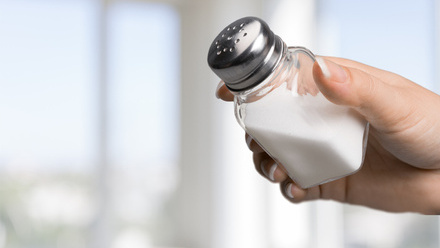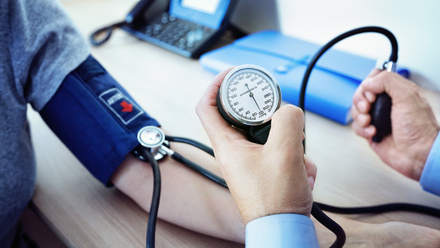This article was written by Dr Sarah Bath, an MRC Population Health Scientist Research Fellow at the University of Surrey who has been researching iodine in the UK since 2006. Sarah is registered dietitian and has worked with the BDA to produce an Iodine Food Fact Sheet.
Though the UK has long been considered to be iodine sufficient, there is increasing concern that this is no longer the case, particularly in women of childbearing age and pregnant women. There is considerably more focus and interest in iodine in the UK than in the past 50 years or so but iodine remains a nutrient that many health professionals are unaware of and is often overlooked.
Iodine is required for the production of thyroid hormones, T4 and T3, and these hormones are required for regulation of metabolic rate, growth and development. A sufficient intake of iodine during pregnancy is vital for the brain and neurological development of the fetus which is dependent on the action of thyroid hormones.
Requirement for iodine and safe upper limit
The UK iodine requirements were set in 1991 and are now outdated, therefore World Health Organisation (WHO) requirements for iodine1 are used in this article. The recommended iodine intake for adults (>12 years) is 150 µg/day.1 (see references below) During pregnancy and lactation, the requirement for iodine rises from 150 to 250 µg of iodine per day.1 The requirement is higher in pregnancy for three reasons:
- to facilitate the 50% surge in thyroid hormone production in early pregnancy,
- to cover potential increased renal loss of iodine during pregnancy and;
- to supply iodine to the fetus to produce its own thyroid hormones after the onset of thyroid function in mid-gestation.
Ensuring an adequate supply of iodine during lactation is essential as breast milk iodine concentration reflects maternal iodine intake and brain development continues in the postnatal period.
It is clear that iodine excess should be avoided as there may be deleterious consequences for thyroid hormone production (both hypo- and hyperthyroidism).2 The safe upper limit is approximately 600 µg/day for adults (>12 years) and pregnant women2 but individuals with chronic iodine deficiency may adversely react to levels lower than this if thyroidal adaptation to low iodine supply has occurred. Individuals with thyroid disease or those who have experienced iodine deficiency over many years should speak to their GP before taking additional iodine.
Iodine deficiency disorders
The 'iodine deficiency disorders' are largely the result of an inadequate production of thyroid hormones. Goitre develops at low iodine intakes and this hyperplasia of the thyroid is an adaptive response to low iodine supply by increasing the iodine-trapping potential of the thyroid. Severe iodine deficiency is known to cause cretinism, a condition characterised by severe learning disability and deafness.2
In the UK and other developed countries, there is more concern about the effects of mild-to-moderate iodine deficiency. There are only two iodine intervention studies that have been conducted in pregnant women in regions of mild-to-moderate iodine deficiency with child cognitive outcomes;3,4 both studies found that iodine supplementation benefitted child cognition though the results should be interpreted with caution as unfortunately neither study was randomised nor placebo controlled.
There are several studies that relate mild thyroid hormone deficiency in pregnancy to a negative effect on child cognitive development5 but these studies have not measured iodine status during pregnancy and therefore, until recently, the effect of in utero mild-to-moderate iodine deficiency on child cognition has been relatively unexplored.
In collaboration with researchers at the University of Bristol, Professor Margaret Rayman and I were able to investigate this relationship by measuring iodine status in 1,040 pregnant women that were recruited to the Avon Longitudinal Study of Parent and Children (ALSPAC) in the 1990s. The results, published in the Lancet in May 2013, showed that low iodine status during early pregnancy (urinary iodine/creatinine ratio <150 µg/g) was significantly associated with the child being in bottom quartile of scores for verbal IQ at age eight (OR 1.58, 95% CI 1.09–2.30; p=0.02), reading accuracy (OR 1.69, 95% CI 1.15-2.49; p=0.007) and reading comprehension (OR 1.54, 95% CI 1.06-2.23; p=0.02) at age nine years following adjustment up to 21 potential confounding variables 6 this study suggests that mild-to-moderate iodine deficiency ALSPAC women was associated with long-lasting effects on child cognition.
Do we get enough iodine in the UK?
In the 1800s, iodine deficiency was historically common in the UK. By the early part of the 20th century a goitre belt was described that extended from the West Country and included Derbyshire – where goitre was so common it was called ‘Derbyshire neck’. Iodine deficiency persisted until the 1960s and was eradicated, not by the usual practice of an iodised-salt programme, but through an adventitious increase in milk-iodine concentration and concurrent increase in milk consumption.7 Milk-iodine concentration increased as a result of changes in the dairy-farming industry with increased use of iodine-fortified cattle feed and iodine-containing disinfectants (iodophors). Between the 1950s and the 1980s, iodine intake increased three-fold and was sufficient to eradicate goitre; 7 it was subsequently assumed that iodine deficiency was not a problem in the UK.
As urinary iodine is considered as good biomarker of iodine status, the WHO recommends comparing the median urinary concentration value from a group of spot-urine samples to published criteria for determining population iodine status.1 The first national survey of iodine status in the UK for more 60 years was reported in 20118 - the urinary iodine results from over 700 schoolgirls (14-15 years) revealed mild iodine deficiency and the authors urged a comprehensive review of iodine status in the UK.8 There are also a number of small, localised studies that measured urinary iodine excretion in women of childbearing age, finding that they were mildly iodine deficient9-11 and deficiency has been demonstrated in pregnant women in south-east12 and north-east England,13 Scotland14 and Cardiff.15
These studies raise concern – they not only suggest that UK pregnant women are not meeting their iodine requirement, but that young women may be entering pregnancy with low thyroidal iodine stores which are inadequate to maintain thyroid function during pregnancy. Evidence suggests that women who have a good supply of iodine prior to conception have a better thyroid hormone profile during pregnancy than those who abruptly increase their iodine intake at the start of pregnancy.16
Dietary sources of iodine
In view of the evidence of iodine deficiency in certain groups of the population and the fact that there is very little information on iodine available to health professionals or the general public, Professor Rayman and I have produced a BDA Iodine Food Fact Sheet.17
The approximate iodine content of a range of foods is shown in Table 1. Milk and dairy products are the principal source of iodine in the UK; other rich sources include seafood and eggs.
There is a known seasonal variation in the iodine content of milk with higher levels in winter milk than summer milk as cows are more reliant on mineral-fortified feed in the winter.7 In addition organic milk has an iodine concentration that is over 40% lower than that of conventional milk.18
Table 1: Approximate iodine concentration in a range of foods17
| Food | Portion (g) | Average iodine/portion (mcg)* |
|---|---|---|
| Conventional milk (cows) | 200 | 50-80** |
| Organic milk (cows) | 200 | 30-65** |
| Conventional yoghurt (cows)‡ | 150 | 50-100** |
| Eggs (hens) | 1 egg: 50g | 20 |
| Cheese (cows)‡ | 40 | 15 |
| White fish | 100 | 115 |
| Oily fish | 100 | 50 |
| Shellfish | 100 | 90 |
| Meat and Poultry | 100 | 10 |
| Nuts | 25 | 5 |
| Bread | 1 slice: 36g | 5 |
| Fruit and vegetables | 1 portion: 80g | 3 |
*Actual iodine content will vary ‡Lower iodine concentration for organic
**Depending on the season, higher value in winter
In contrast with many other countries, the UK has not introduced a programme of iodine fortification such as salt iodisation. Most salt on sale in the UK is not iodised19 and iodised salt is not used in food processing.
Kelp supplements should not be used as an iodine source and should not be recommended to pregnant women owing to the risk of excessive iodine intake.2
Individuals at risk of deficiency
Anyone who completely avoids dairy products and fish or consumes them in limited quantities is at risk of iodine deficiency. Vegans are a recognised at-risk group for many nutrient deficiencies, including iodine and vegetarians may also have a low iodine intake depending on the amount of milk and dairy products in their diet. Many dairy-milk substitutes (e.g. soya milk) are not enriched with iodine.
It is important to note that there is no method for diagnosing iodine deficiency in an individual; urinary iodine concentration can be used to assess the status of a group or population, but it is inappropriate for use in an individual. A dietary assessment will reveal those who are not frequent consumers of iodine-rich foods and should ring warning bells; if concerned, the individual could be referred to their GP for thyroid-function tests.
Conclusions
There is evidence that certain groups of the UK population, particularly pregnant women and women of childbearing age, are iodine deficient which is therefore of considerable public-health concern. In the absence of official guidance, UK women of childbearing age should ensure that iodine requirements are met, ideally prior to conception, to optimise thyroidal stores, and iodine deficiency should particularly be avoided during pregnancy and lactation.
References
1. WHO, UNICEF, ICCIDD. Assessment of iodine deficiency disorders and monitoring their elimination, 3rd edition Geneva: World Health Organisation, 2007.
2. Zimmermann MB. Iodine deficiency. Endocr Rev 2009;30(4):376-408.
3. Berbel P, Mestre JL, Santamaria A, et al. Delayed neurobehavioral development in children born to pregnant women with mild hypothyroxinemia during the first month of gestation: the importance of early iodine supplementation. Thyroid 2009;19(5):511-9.
4. Velasco I, Carreira M, Santiago P, et al. Effect of iodine prophylaxis during pregnancy on neurocognitive development of children during the first two years of life. J Clin Endocrinol Metab 2009;94(9):3234-41.
5. Melse-Boonstra A, Jaiswal N. Iodine deficiency in pregnancy, infancy and childhood and its consequences for brain development. Best Pract Res Clin Endocrinol Metab 2010;24(1):29-38.
6. Bath SC, Steer CD, Golding J, Emmett PM, Rayman MP. Effect of inadequate iodine status in UK pregnant women on cognitive outcomes in their children: results from the Avon Longitudinal Study of Parents and Children (ALSPAC). Lancet 2013:doi:10.1016/S0140-6736(13)60436-5.
7. Phillips DI. Iodine, milk, and the elimination of endemic goitre in Britain: the story of an accidental public health triumph. J Epidemiol Community Health 1997;51(4):391-3.
8. Vanderpump MP, Lazarus JH, Smyth PP, et al. Iodine status of UK schoolgirls: a cross-sectional survey. Lancet 2011;377(9782):2007-12.
9. Bath S, Walter A, Taylor A, Rayman MP. Iodine status of UK women of childbearing age. J Hum Nutr Diet 2008;21:379-80.
10. Rayman MP, Sleeth M, Walter A, Taylor A. Iodine deficiency in UK women of child-bearing age. Proc Nut Soc 2008;67:E399.
11. Lampropoulou M, Lean M, Combet Aspray E. Iodine status of women of childbearing age in Scotland. Proc Nutr Soc 2012;71:E143
12. Bath SC, Walter A, Taylor A, Wright J, Rayman MP. Iodine deficiency in pregnant women living in the South-East of the UK: the influence of diet and nutritional supplements on iodine status. Br J Nutr 2014: E publicatation 7 January 2014; .
13. Kibirige MS, Hutchison S, Owen CJ, Delves HT. Prevalence of maternal dietary iodine insufficiency in the north east of England: implications for the fetus. Arch Dis Child Fetal Neonatal Ed 2004;89(5):F436-9.
14. Barnett C, Visser T, Williams F, et al. Inadequate iodine intake of 40% of pregnant women from a region in Scotland. J Endocrinol Invest 2002;25:(Supp. No. 7) 90, P110.
15. Pearce EN, Lazarus JH, Smyth PP, et al. Perchlorate and thiocyanate exposure and thyroid function in first-trimester pregnant women. J Clin Endocrinol Metab 2010;95(7):3207-15.
16. Moleti M, Di Bella B, Giorgianni G, et al. Maternal thyroid function in different conditions of iodine nutrition in pregnant women exposed to mild-moderate iodine deficiency: an observational study. Clin Endocrinol (Oxf) 2011;74(6):762-8.
17. Bath SC, Rayman MP. BDA Food Fact Sheet - Iodine. British Dietetic Association, 2013.
18. Bath SC, Button S, Rayman MP. Iodine concentration of organic and conventional milk: implications for iodine intake. Br J Nutr 2012;107(7):935-40.
19. Bath S, Button S, Rayman MP. Availability of iodised table salt in the UK – is it likely to influence population iodine intake? Public Health Nutr 2013:E-Pub 16 Jan.







